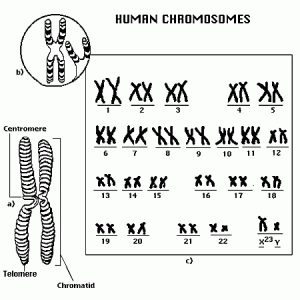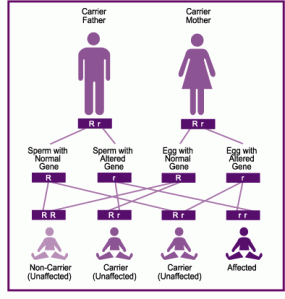Cells
Posted by ldlechmt in Uncategorized on November 11, 2011
Cells
- Cells are highly organized and contain a nucleus which stores the hereditary material (DNA) and coordinates the cell’s activities such as growth, metabolism, protein synthesis, and reproduction.
- Inside each nucleus of human cells is about 6 feet of DNA, which is then divided into 46 molecules (one for each chromosome). The DNA must be properly packed into the cells- not crammed or stuffed in. If something is wrong within the DNA or if it is packed incorrectly, then there is something wrong with the directions of the cell.
- DNA also combines with other proteins and dense fiber called chromatin which then condense later into chromosomes.
Chromosomes
Posted by ldlechmt in Uncategorized on November 11, 2011
Chromosomes
Our genes are lined up on chromosomes, which come in 23 pairs (46 total). Half of a child’s chromosome comes from one parent, the other half comes from the other parent
22 of the pairs look very similar, if not identical. These are called autosomes. The other 2 chromosomes are called sex chromosomes, and are X and Y. Females have two X chromosomes, while males have one X and one Y. 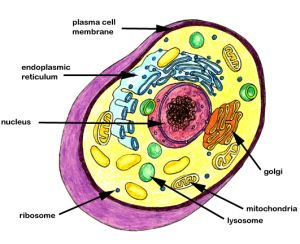
Most living organisms are made up of cells. These cells contain a nucleus that contains a substance called deoxyribonucleic acid (DNA). DNA is wrapped together to form structures called chromosomes. Most cells in the human body have 23 pairs of chromosomes, making a total of 46. You received half of your chromosomes from your mother’s egg and the other half from your father’s sperm cell. The two chromosomes of a pair (except for the sex chromosomes) contain the same genes, but the genes have small differences. A male child receives an X chromosome from his mother and a Y chromosome from his father; females get an X chromosome from each parent, these are called sex chromosomes. You don’t necessarily end up with a matching pair. Typically females have two X chromosomes and males have an X and a Y. Mothers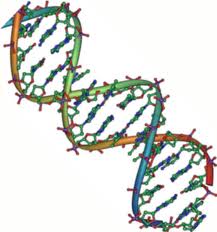 always pass an X chromosome on to their children. Whether your father passes on his X chromosome (leading to a pair of X chromosomes) or his Y chromosome (making a mixed set) determines your sex. Though most adult cells contain two sets of chromosomes, sperm and egg cells are different. These special cells have just one chromosome from each pair. When a sperm and egg cell join together at fertilization they create a single cell with two complete sets of 23 chromosomes. This single cell divides to create new cells, over and over, forming the body of developing child. If you have children, the same events created them. But because the egg and sperm production processes are random, your children didn’t get the same set of chromosomes from each parent.
always pass an X chromosome on to their children. Whether your father passes on his X chromosome (leading to a pair of X chromosomes) or his Y chromosome (making a mixed set) determines your sex. Though most adult cells contain two sets of chromosomes, sperm and egg cells are different. These special cells have just one chromosome from each pair. When a sperm and egg cell join together at fertilization they create a single cell with two complete sets of 23 chromosomes. This single cell divides to create new cells, over and over, forming the body of developing child. If you have children, the same events created them. But because the egg and sperm production processes are random, your children didn’t get the same set of chromosomes from each parent.
Sections or segments of DNA that are carried on the chromosomes determine specific human characteristics, such as height or hair color. Cells can sometimes contain changes or variants in the information in their chromosomes. This is called a mutation, and it often occurs when cells are aging or have been exposed to certain chemicals or radiation. Fortunately, cells usually recognize these mutations and repair them by themselves. Other times, however, they can cause illnesses or diseases. And if the gene mutation exists in egg or sperm cells, children can inherit the mutated gene from their parents.
http://www.youtube.com/watch?v=T76usaEe7yE
http://ghr.nlm.nih.gov/handbook/basics/chromosome
Mendel’s Three Laws
Posted by ldlechmt in Uncategorized on November 11, 2011
Mendel’s Three Laws
- Mendel was a scientist who developed laws of inheritance. They are as follows:
- Law of Dominance: when there are alternate forms of a gene, the gene that will be expressed is the dominant form
- Law of Segregation: inherited traits are defined by gene pairs, and sex cells contain only one gene of the pair
- Law of independent assortment: inheritance of one trait is not dependent on the inheritance of the other because traits are arranged separately from each other.
- Beneficial information: http://www.hobart.k12.in.us/jkousen/Biology/mendel.htm
- Genes or traits can be expressed by a capital letter in a Punnett Square. You take the trait of the mother and the trait of the father and put one on the column and the other on the row. Lets say that a capital ‘T’ means the child will be taller than average, the lower-case ‘t’ means the child will be shorter than average. When there is a capital ‘T’, it will be expressed.
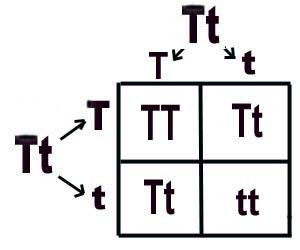
Here the trait that is capitalized will be expressed by splitting the genotype letters and putting them on the column, or on the row so you segregate (Law 2) the traits. This forms the possibility that the child will have a 75% chance of being tall and a 25% chance of being short
- Another way of viewing traits is something similar to this diagram as well:
Genetics
Posted by ldlechmt in Uncategorized on November 11, 2011
Did you know?!
- As many as 3 to 4% of all children are born with genetic anomalies and as many as 10% will have problems of genetic origin by the age of 1 year.
- 7 in every 1000 births are affected by a chromosomal disorder.
DNA/Genes
- Each cell in the human body contains about 25,000-35,000 genes that carry the information to determine your traits.
- DNA stands for Deoxyribonucleic acid that is found at the center of almost every cell. It carries the code for nearly all inherited traits from each parent in packages called chromosomes.
- DNA, or our genes, contain the instructions for making proteins in your body.
- Gene Expression is a highly specific process where a gene is switched on.
Here is an example of the DNA structure: http://www.youtube.com/watch?v=qy8dk5iS1f0
Beneficial Website that explains genetics in a non-complicated manner: http://kidshealth.org/kid/talk/qa/what_is_gene.html#
Genetics information: http://learn.genetics.utah.edu/
